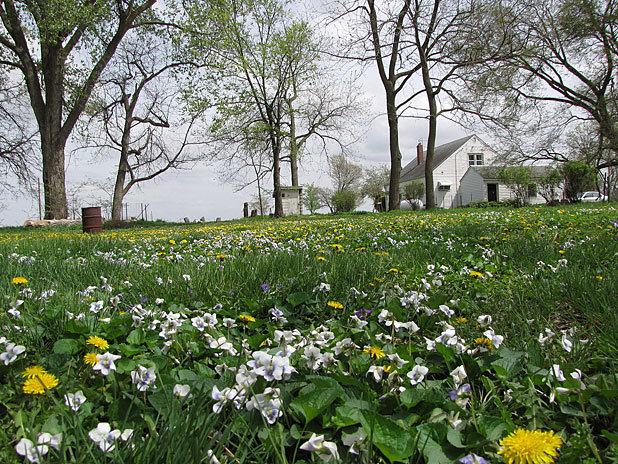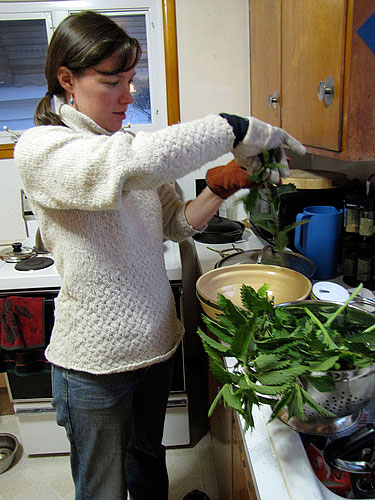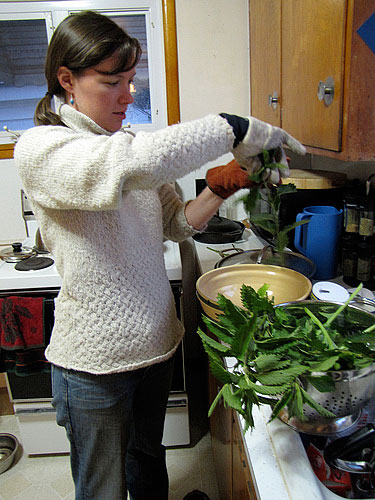 Flowers or weeds? Depends on what you’re in the mood for.(Steph Larsen photos)
Flowers or weeds? Depends on what you’re in the mood for.(Steph Larsen photos)
 The first edible plant to poke its head out of the ground at my farm early this spring wasn’t lettuce, arugula, broccoli, or any other hardy plant widely seen at early farmers markets.
The first edible plant to poke its head out of the ground at my farm early this spring wasn’t lettuce, arugula, broccoli, or any other hardy plant widely seen at early farmers markets.
It was stinging nettles.
As a child, I nicknamed Urtica dioica “itch weed” because of the blistering rash that appears if you brush against it. It wasn’t until graduate school that I found out nettles are edible once dried or sautéed, which neutralizes the tiny stinging hairs they have.
After this past long Nebraska winter, I was starving for something fresh and green, so when I found them growing in our field I grabbed my garden gloves and started harvesting. Brian, my partner, took a little convincing when I suggested we make rotini alfredo with nettles, but he was brave. I’m happy to report that he thought they had a pleasant, nutty flavor. I think it’s the only time I’ve chopped anything for dinner with gloves on, but I’ll bet it’s not my last.
The rest of the yard began sprouting not long after the nettles appeared, and we discovered a carpet of violets between our outbuildings. The purple and white flowers made a nice contrast with the yellow dandelions, and I knew then that spring had arrived.
I was surprised, then, when Brian started picking the flowers and munching them while we pondered where to put the garden. Turns out that violets have a fresh taste and a pleasant crunch that goes well with deep thinking. I was so excited about this that I briefly considered planting our 5-acre pasture entirely to violets and selling the edible flowers to high-end restaurants to use in salads and as garnish, thereby making a fortune.
Clearly Mother Nature was listening when I joked about this plan, and she is not without a sense of irony. By far the biggest weed problem I have in my garden right now is violets. It seems that when violets are tilled, the broken root pieces are still viable and can sprout new plants. I’ve tried to make a deal with the violets that they can have the rest of the yard if I can have just my garden violet-free, but so far they haven’t taken me up on it.
 What could smell lovelier than freshly perked coffee? Phlox!The word “weed” has such a negative connotation, but really weeds are just “plants out of place,” as someone once said. I’m starting to realize that plants I didn’t intentionally put on our farm can be very useful. For example, I don’t think of it as “mowing grass” at our house — instead, we’re harvesting mulch for the sapling trees we planted. The wild asparagus is delicious, the bromegrass keeps the sheep fed while the pasture grows, and the garden phlox makes my house smell lovely. Someday I’d like to brew dandelion wine, but I think that’s for another year.
What could smell lovelier than freshly perked coffee? Phlox!The word “weed” has such a negative connotation, but really weeds are just “plants out of place,” as someone once said. I’m starting to realize that plants I didn’t intentionally put on our farm can be very useful. For example, I don’t think of it as “mowing grass” at our house — instead, we’re harvesting mulch for the sapling trees we planted. The wild asparagus is delicious, the bromegrass keeps the sheep fed while the pasture grows, and the garden phlox makes my house smell lovely. Someday I’d like to brew dandelion wine, but I think that’s for another year.
Even kudzu, the invasive weed nicknamed “the vine that ate the South,” has important uses as a starchy food, a medicine to treat hangovers and control alcohol cravings, and for lotions and soaps. I first learned about kudzu from the book My Year of Meats by Ruth Ozeki, and it occurred to me then that one way to control a weed is to find enough ways to use the plant so that people want to harvest it.
As useful as weeds can be, they can still get in the way of plants I’m trying to grow. Still, when I’m in a bad mood, there’s nothing quite as satisfying as to take my aggression out on a patch of stubborn crabgrass. Just don’t tell my neighbors, or soon I’ll have everyone inviting me over to weed their gardens, too.
Recipe: Fettuccine with Nettle & Ricotta Pesto
I use nettles in soup, pasta, eggs, sauteed with butter and garlic as a side — anywhere you’d use spinach or kale. But this recipe, courtesy of Mariquita Farm’s newsletter, looks especially tasty.
Created by Armando “Tiny” Maes of Lavanda in Palo Alto, it serves 8 people.
1 lb fettuccine (preferably fresh)
1/2 pound nettles
6 oz. ricotta
5 oz. pine nuts
1/4 cup pecorino
2 tablespoons parmesan
3 tablespoons green garlic (chopped)
1 1/4 cup Olive Oil
8 tablespoons sea salt
6 tablespoons butter
First, blanch the nettles in salted water. Bring a gallon of water and 4 tablespoons of the sea salt to a boil. Blanch for about 1 minute. (Trick: put the nettles in a strainer, then set the strainer in the pot of water. After a minute, take the strainer out. It saves having to fish the leaves out.) Roughly chop the cooked nettles and squeeze out excess water.
Place the nettles into a blender or food processor; add oil, 4 ounces of pine nuts (saving the rest as a garnish), and the green garlic. Blend until all ingredients are combined, about 30 seconds to 1 minute.
Place the combined ingredients in a bowl, add pecorino, parmesan, and ricotta. Finish the pesto by folding in the three cheeses just until it looks like everything has come together.
In a separate pot, bring 2 quarts water and the remaining 4 tablespoons of the sea salt to a boil to cook the pasta. (You should be able to taste the salt in the water; if not, add more.)
In another large saucepan or large sauté pan, place about just less than half of the pesto mixture and 6 tablespoons butter and heat until hot but not boiling or popping. In the pot, cook the pasta for approximately 2 to 4 minutes, remove 1/4 cup of the pasta water and reserve in case you need to thin the pesto.
Pull the pasta from the water, drain, and toss with the warmed pesto sauce, then cook on medium heat for just about 2 to 3 minutes so that the sauce has time to infuse into the pasta. Serve with good bread.


